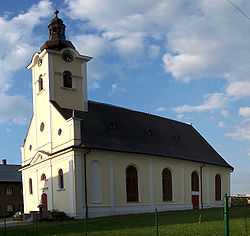Dolní Bludovice

![]() Dolní Bludovice (Polish: Błędowice Dolne , German: Nieder Bludowitz) is a village in Karviná District, Moravian-Silesian Region, Czech Republic. It was a separate municipality but after the expansion of the city of Havířov created in 1955 it became administratively a part of this city as Bludovice in 1960. Lučina River flows through the village. Large part of the population of Dolní Bludovice is Polish. It has a population of 2,619 (2010).[1] The village lies in the historical region of Cieszyn Silesia.
Dolní Bludovice (Polish: Błędowice Dolne , German: Nieder Bludowitz) is a village in Karviná District, Moravian-Silesian Region, Czech Republic. It was a separate municipality but after the expansion of the city of Havířov created in 1955 it became administratively a part of this city as Bludovice in 1960. Lučina River flows through the village. Large part of the population of Dolní Bludovice is Polish. It has a population of 2,619 (2010).[1] The village lies in the historical region of Cieszyn Silesia.
History
The village was first mentioned in a written document as a seat of a Catholic parish in an incomplete register of Peter's Pence payment from 1335 as Bluda[2] and as such the parish was one of the oldest in the region. It was again mentioned in the register of Peter's Pence payment from 1447 among 50 parishes of Teschen deanery as Bluda.[3]
Politically the village belonged initially to the Duchy of Teschen, formed in 1290 in the process of feudal fragmentation of Poland and was ruled by a local branch of Piast dynasty. In 1327 the duchy became a fee of the Kingdom of Bohemia, which after 1526 became part of the Habsburg Monarchy.
After the 1540s Protestant Reformation prevailed in the Duchy of Teschen and a local Catholic church was taken over by Lutherans. It was taken from them (as one from around fifty buildings in the region) by a special commission and given back to the Roman Catholic Church in 1654.[4] In spite of being bereft of place of worship many of the local inhabitants remained to be Lutherans. After issuing the Patent of Toleration in 1781 they subsequently organized a local Lutheran parish as one of over ten in the region.[5]
After Revolutions of 1848 in the Austrian Empire a modern municipal division was introduced in the re-established Austrian Silesia. The village as a municipality was subscribed to the political and legal district of Cieszyn. According to the censuses conducted in 1880, 1890, 1900 and 1910 the population of the municipality grew from 1986 in 1880 to 2548 in 1910 with a majority being native Polish-speakers (at least 92.3% in 1880, at most 97.8% in 1890) accompanied by a Czech-speaking minority (at most 102 or 5.2% in 1880) and German-speaking (at most 49 or 2.5% in 1880). In terms of religion in 1910 majority were Protestants (85.2%), followed by Roman Catholics (12.9%), Jews (26 or 1.2%) and 20 people adhering to another faiths.[6] The village was also traditionally inhabited by Silesian Lachs, speaking Cieszyn Silesian dialect.
After World War I, fall of Austria-Hungary, Polish–Czechoslovak War and the division of Cieszyn Silesia in 1920, it became a part of Czechoslovakia. Following the Munich Agreement, in October 1938 together with the Zaolzie region it was annexed by Poland, administratively adjoined to Cieszyn County of Silesian Voivodeship.[7] It was then annexed by Nazi Germany at the beginning of World War II. After the war it was restored to Czechoslovakia.
There are now three cemeteries in the village, Lutheran church, Roman Catholic church and two elementary schools (Polish and Czech).
People
- Wiesław Adam Berger, Polish writer, lived there
- Józef Kiedroń, Polish engineer and politician, was born here
Gallery
-

Entrance gate to the Old Protestant cemetery
-

New Protestant cemetery
-

Catholic cemetery
-

Saint Margaret church
-

PZKO House
-

Monument dedicated to victims of World War II, erected by members of local PZKO
-

Polish elementary school
-

Czech elementary school
-

Lučina River
See also
| Wikimedia Commons has media related to Dolní Bludovice. |
Footnotes
- ↑ Statistics of Havířov
- ↑ Ptaśnik, Jan (1913). Monumenta Poloniae Vaticana T.1 Acta Camerae Apostolicae. Vol. 1, 1207-1344. Cracoviae: Sumpt. Academiae Litterarum Cracoviensis. p. 366.
- ↑ "Registrum denarii sancti Petri in archidiaconatu Opoliensi sub anno domini MCCCCXLVII per dominum Nicolaum Wolff decretorum doctorem, archidiaconum Opoliensem, ex commissione reverendi in Christo patris ac domini Conradi episcopi Wratislaviensis, sedis apostolice collectoris, collecti". Zeitschrift des Vereins für Geschichte und Alterthum Schlesiens (in German) (Breslau: H. Markgraf) 27: 361–372. 1893. Retrieved 21 July 2014.
- ↑ Broda, Jan (1992). "Materiały do dziejów Kościoła ewangelickiego w Księstwie Cieszyńskim i Państwie Pszczyńskim w XVI i XVII wieku". Z historii Kościoła ewangelickiego na Śląsku Cieszyńskim (in Polish). Katowice: Dom Wydawniczy i Księgarski „Didache“. pp. 259–260. ISBN 83-85572-00-7.
- ↑ Michejda, Karol (1992). "Dzieje Kościoła ewangelickiego w Księstwie Cieszyńskim (od Reformacji do roku 1909)". Z historii Kościoła ewangelickiego na Śląsku Cieszyńskim (in Polish). Katowice: Dom Wydawniczy i Księgarski „Didache“. p. 143. ISBN 83-85572-00-7.
- ↑ Piątkowski, Kazimierz (1918). Stosunki narodowościowe w Księstwie Cieszyńskiem (in Polish). Cieszyn: Macierz Szkolna Księstwa Cieszyńskiego. p. 263, 281.
- ↑ "Ustawa z dnia 27 października 1938 r. o podziale administracyjnym i tymczasowej organizacji administracji na obszarze Ziem Odzyskanych Śląska Cieszyńskiego". Dziennik Ustaw Śląskich (in Polish) (Katowice). nr 18/1938, poz. 35. 31 October 1938. Retrieved 1 July 2014.
References
- Zahradnik, Stanisław (1991). Struktura narodowościowa Zaolzia na podstawie spisów ludności 1880-1991. Trzyniec: HT. OCLC 189422554.
Coordinates: 49°45′59″N 18°26′19″E / 49.76639°N 18.43861°E